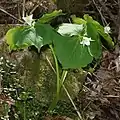Trilliaceae was a family of flowering plants first named in 1846; however, most taxonomists now consider the genera formerly assigned to it to belong to the family Liliaceae. The APG IV system, of 2016 (unchanged from the APG system, of 1998), does not recognize such a family either and assigns the plants involved to family Melanthiaceae, tribe Parideae.
Nevertheless, some taxonomists still recognize a separate family Trilliaceae. The most important genus in North America is Trillium, and the taxonomy of that genus has always been controversial.
A recent treatment (Farmer and Schilling 2002) stated that the family Trilliaceae, which exhibits an arcto-tertiary distribution, comprises six genera. Three of these exhibit a wide distribution:
- Paris from Iceland to Japan,
- Daiswa from eastern Asia, and
- Trillium from North America and eastern Asia
Three are monotypic, endemic genera:
- Trillidium govanianum, with a tepaloid inflorescence, from the Himalayan Mountains;
- Kinugasa japonica, with petaloid sepals, from Japan; and
- Pseudotrillium rivale, newly segregated, with spotted petals, from the Siskiyou Mountains of California and Oregon.
Within Melanthiaceae, these are consolidated into three genera;
- Parideae
- Paris L. (including Daiswa and Kinugasa)
- Pseudotrillium S.B.Farmer
- Trillium L. (including Trillidium)
 Paris quadrifolia in flower
Paris quadrifolia in flower.jpg.webp) Paris quadrifolia in fruit
Paris quadrifolia in fruit Paris quadrifolia from Sturm (1796)
Paris quadrifolia from Sturm (1796) Trillium grandiflorum
Trillium grandiflorum Trillium luteum
Trillium luteum Trillium luteum
Trillium luteum Trillium ovatum
Trillium ovatum Trillium tschonoskii
Trillium tschonoskii
External links
- Susan Farmer's web pages on Trilliaceae and the genus Trillium
- Farmer & Schilling 2002 -- article in Systematic Botany on Trilliaceae
- Trilliaceae in L. Watson and M.J. Dallwitz (1992 onwards). The families of flowering plants: descriptions, illustrations, identification, information retrieval. Version: 3 May 2006. http://delta-intkey.com.
- links at CSDL, Texas
- history and placement of taxa in Trilliaceae
- morphological characters of genera within Melanthiaceae sensu APG II
